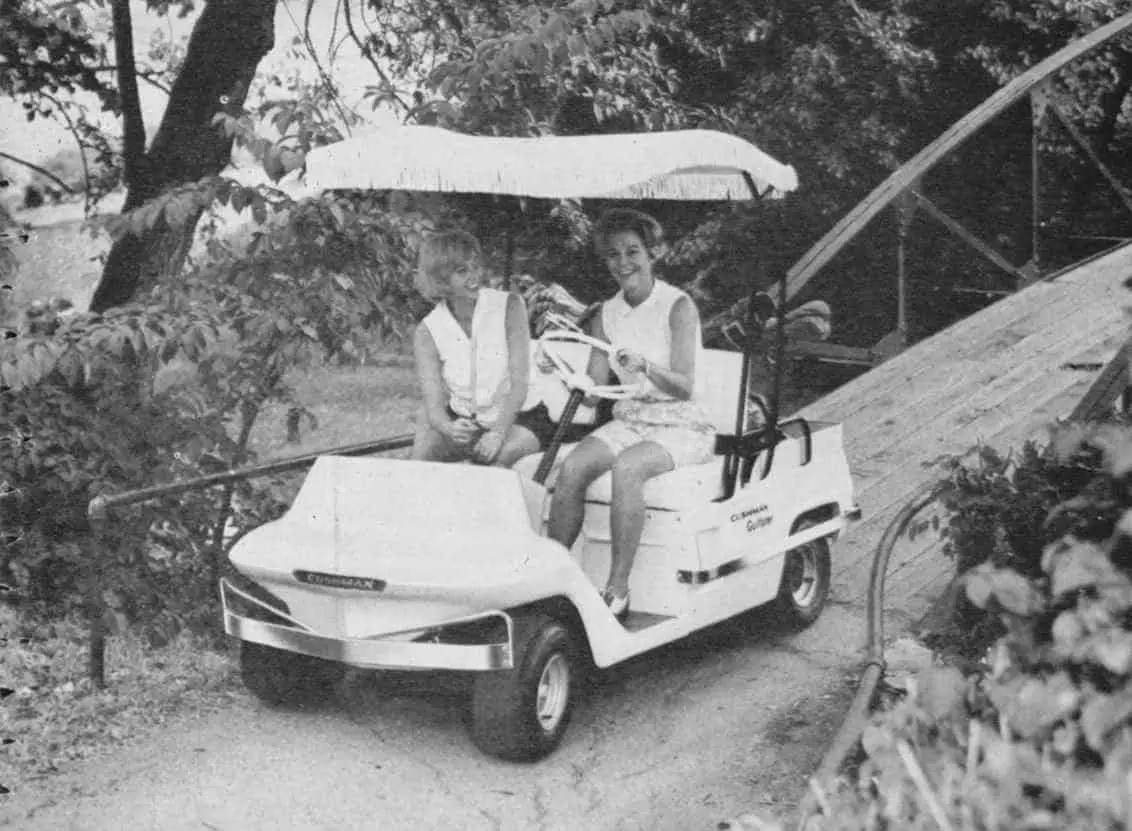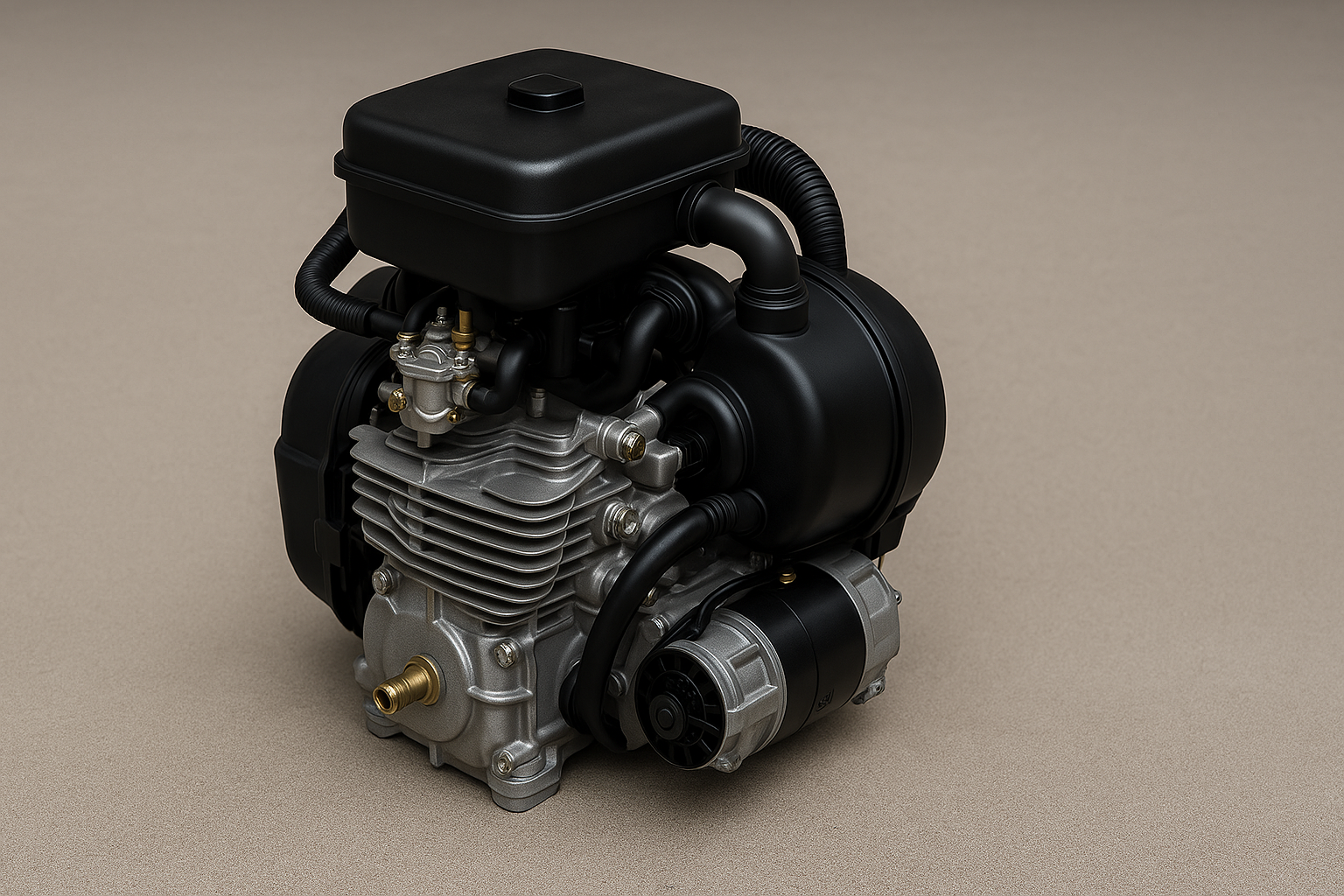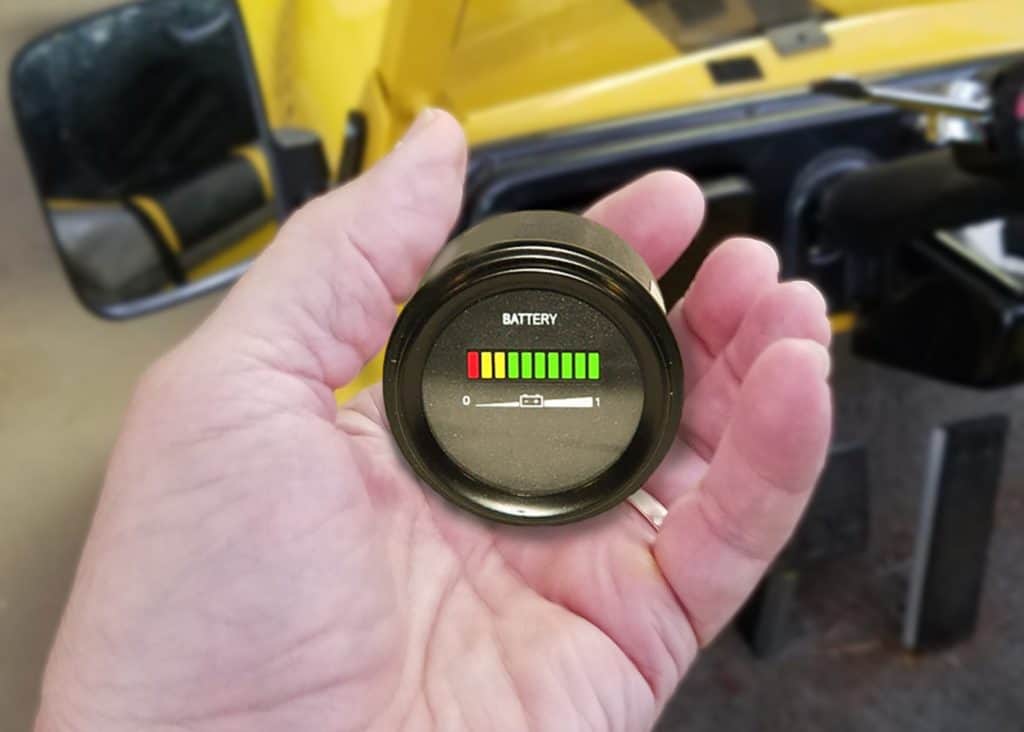You’ve hopped on a golf cart, but ever pondered how it works? Prepare to delve into the intricate mechanics of these nifty vehicles.
You’ll explore the power behind electric and gas models, marvel at compact design efficiencies, and understand the role of engines, batteries, and drivetrains.
Strap in as we journey through the golf cart’s inner workings – you’re about to appreciate your next fairway ride on a whole new level.
Key Takeaways
- Golf carts are powered by either electric motors or small gasoline engines, with the throttle controlling the speed by adjusting the power to the motor or engine.
- The propulsion of a golf cart is managed by a series of batteries that store electricity, and motor controllers regulate the speed by adjusting the electrical current to the motor.
- The steering system uses a rack and pinion mechanism, while the suspension system absorbs shocks and bumps for a smooth ride.
- Regular maintenance, including tire rotation, battery terminal cleaning, and proper tire pressure, is essential for the optimal performance and lifespan of a golf cart.
Understanding the Basics of Golf Cart Operation
You’ve probably noticed that your golf cart operates differently than your car, and you’re right, it does. A golf cart’s operation can be broken down into two major functions: propulsion and steering.
Propulsion in a golf cart is typically managed by an electric motor or a small gasoline engine. If it’s electric, the motor is powered by a bank of rechargeable batteries. The throttle controls the speed by increasing or decreasing the power to the motor. In the case of a gasoline engine, it functions similarly to your car’s engine but on a smaller scale, providing power to the wheels through a series of belts and a differential.
Steering, on the other hand, is controlled by a simple rack-and-pinion system, just like in a car. When you turn the steering wheel, it turns a small pinion gear. This gear moves a larger gear, or the rack, which is connected to the front wheels, directing the cart left or right.
The Role of Electricity in Golf Carts
Now that you understand the basic functions of your golf cart, let’s delve into the role of electricity, a key component in powering your cart’s motor.
Electricity is the crucial lifeblood that keeps your golf cart moving. It’s stored in a series of batteries, typically six 6-volt batteries for a total of 36 volts, or six 8-volt for a total of 48 volts.
When you turn your cart’s key or flip the switch to ‘on’, the electrical system springs into action. Current flows from the batteries to the motor, setting your cart in motion. The accelerator controls the flow of electricity, allowing you to modulate the speed of your cart. Press it down, and more electricity flows, speeding up the motor. Release it, and the flow decreases, slowing the cart.
Electric golf carts also have a charger onboard, which plugs into an AC outlet to replenish the batteries. It’s important to keep this charger in good condition and use it regularly, as running your golf cart on low batteries can damage the electrical system.
Anatomy of a Golf Cart: Key Components
In understanding the workings of your golf cart, it’s essential to get acquainted with its key components.
Firstly, the engine or motor, which can be either gas or electric, propels the cart forward. Gas engines are typically four-stroke engines, while electric motors are powered by rechargeable batteries.
Next, the drivetrain transfers power from the engine to the wheels. This system includes the transmission, drive shaft, and differential. The transmission adjusts the power output from the engine to the wheels, while the differential allows the wheels to rotate at different speeds for smoother turns.
The steering system, composed of the steering wheel, steering column, and tie rods, guides the golf cart in the desired direction. The brake system, which includes the brake pedal, master cylinder, and brake lines, slows or stops the vehicle.
The suspension system, consisting of springs, shock absorbers, and linkages, ensures a smooth ride over uneven terrain. Lastly, the body of the golf cart provides protection and aesthetic appeal. It’s made of durable materials like steel or aluminum and often features a roof and windshield for comfort and safety.
Each of these components plays a vital role in the operation and functionality of your golf cart.
The Function of Golf Cart Batteries
As a vital part of your golf cart’s mechanics, the batteries provide the power necessary for the cart’s operation. They store electrical energy and convert it into kinetic energy to propel the cart forward. This process is achieved through a complex series of chemical reactions within the battery cells.
Here’s a more detailed look at how they function:
- Energy Storage and Release
- When you charge your golf cart’s battery, an electrical current is sent into the cells, causing a chemical reaction that stores energy.
- When you start the cart, this process is reversed. The stored energy is converted back into an electrical current, which powers the motor.
- Battery Maintenance
- Regular maintenance is critical to extend the lifespan of your golf cart batteries. This involves checking the water levels and keeping the terminals clean.
- Over time, batteries will need to be replaced. The frequency of replacement depends on usage and how well they’re maintained.
How Motor Controllers Regulate Speed
After understanding the function of golf cart batteries, you’ll find it’s through the use of motor controllers that your cart’s speed is regulated. This component is crucial in managing the efficiency and performance of your golf cart.
The motor controller is essentially the brain of your golf cart. It receives inputs from the accelerator pedal and then sends signals to the motor to control speed. You see, when you press down on the pedal, the controller translates this action into an electrical signal, which it sends to the motor, dictating the amount of power it should draw from the batteries.
In essence, by regulating the electrical current flowing from the battery to the motor, the controller can adjust the speed. If you press harder on the accelerator, more current is allowed to flow, increasing the speed. Ease up on the pedal, and the controller reduces the current, slowing down the cart.
Motor controllers also play a role in regenerative braking, a feature in some modern golf carts. This process recovers energy during braking and feeds it back into the battery, improving the cart’s efficiency.
The Importance of the Drivetrain
Now that you’ve got a clear idea about how motor controllers influence your golf cart’s speed, let’s explore a crucial component that directly impacts your cart’s movement – the drivetrain.
The drivetrain consists of all the components that transmit power from the engine or motor to the wheels, including the transmission, differential, and axles. It’s essentially the lifeline of your golf cart and plays an integral role in its operation.
Here’s a glimpse into the importance of a well-functioning drivetrain:
- Transmission of Power: The drivetrain receives input from the motor controller and efficiently transfers power to the wheels. This is fundamental for the golf cart to move.
- Smooth Operation: A well-maintained drivetrain ensures smooth operation, reducing the risk of mechanical failures and enhancing the overall riding experience.
- Fuel Efficiency: The drivetrain’s efficiency directly affects the golf cart’s fuel consumption. A well-tuned drivetrain can help optimize fuel usage.
- Maintenance and Longevity: Regularly servicing the drivetrain can extend the lifespan of your golf cart and minimize unnecessary repair costs.
Understanding the drivetrain’s role in your golf cart’s operation can help you maintain it properly, ensuring optimal performance and longevity of your cart.
Steering and Suspension: Ensuring Smooth Rides
Just as the drivetrain plays a pivotal role in your golf cart’s operation, the steering and suspension system is equally essential, ensuring you enjoy a smooth and comfortable ride. The steering mechanism in most golf carts is a simple rack and pinion system, where the rotation of a pinion gear causes linear motion in a rack, turning the wheels. This system is both reliable and easy to maintain.
The suspension, on the other hand, is what absorbs shocks and bumps, smoothing out the ride. Most golf carts use a leaf spring suspension system, a tried-and-true technology that’s been used in vehicles for over a century. The leaf springs flex and absorb energy when you go over a bump, then return to their normal shape, keeping the cart stable.
Your cart’s tires also play a role in smoothing the ride. They’re typically wider and softer than car tires, helping to distribute the weight of the cart and its passengers, reducing the impact of any bumps or rough patches.
Golf Cart Braking System: How It Works
As you navigate those smooth rides, it’s the golf cart’s braking system that ensures your safety and control. The braking system, typically hydraulic, operates similarly to that of a regular car. The system engages when you press the brake pedal, which forces hydraulic fluid through the brake lines, causing the brake pads to clamp onto the wheel’s rotor.
Here’s a more detailed breakdown:
- Hydraulic Brakes: When the brake pedal is pressed:
- Brake Fluid: This is pushed through the brake lines. It’s the hydraulic fluid that transfers the force of your foot on the pedal to the brakes.
- Brake Pads: These clamp onto the rotor, creating friction that slows and eventually stops the wheel.
Maintenance: Regular inspection and maintenance are essential:
- Brake Fluid: Check regularly for adequate levels. Refill if necessary.
- Brake Pads: Monitor for wear and replace when needed.
The Role of Tires in Golf Cart Functionality
While ensuring your golf cart’s brakes are in top shape, don’t overlook the pivotal role your tires play in the cart’s overall functionality. Tires are crucial components that enhance the cart’s performance, stability, and safety on the golf course.
First, let’s talk about traction. Golf cart tires are designed with deep treads to provide optimal grip on the grass and rough terrains of a golf course. Without adequate traction, your cart could skid or slide, especially when making turns or going uphill.
Next, consider the impact of tire pressure. Properly inflated tires ensure a smoother ride, reduce the risk of tire damage and premature wear, and improve the cart’s fuel efficiency. Conversely, under-inflated tires can cause your cart to drag, putting extra strain on the engine, while over-inflated tires can lead to a bumpy ride and increased risk of punctures.
Lastly, the size of your tires matters too. Larger tires can increase the ground clearance of your cart, allowing it to traverse rougher terrains without scraping the bottom. However, larger tires can also increase the cart’s top speed, so make sure your brakes are up to the task.
Maintenance Tips for a Golf Cart’s Longevity
Now that you’ve got a grasp on the role of tires in your golf cart’s functionality, let’s move into some essential maintenance tips to ensure your cart’s longevity. Regular maintenance can significantly improve the lifespan and performance of your golf cart.
- Battery Care
- Regular Checking: Inspect your golf cart’s battery weekly. Look for any signs of corrosion, leaks, or other damages.
- Proper Cleaning: Use a mixture of baking soda and water to clean battery terminals. This prevents build-up and enhances battery life.
- Tire Maintenance
- Tire Pressure: Ensure your tires are inflated to the manufacturer’s recommended level. Incorrect pressure can lead to poor performance and increased wear.
- Rotation: Rotate your tires every six months to ensure even wear.
Remember, your golf cart’s lifespan isn’t solely defined by the quality of its components, but also how well those components are maintained. By following these tips, you can ensure your golf cart remains functional and efficient for years to come.
A well-maintained golf cart not only provides a more enjoyable ride but also minimizes the need for costly repairs.
Common Golf Cart Issues and Their Solutions
Even though you’re maintaining your golf cart well, you might still encounter some common issues, so let’s delve into their solutions to keep your cart running smoothly.
Among the most common problems are battery issues, tire problems, and electrical malfunctions. Battery-related problems are usually the result of poor maintenance or an aged battery. Regularly cleaning the battery terminals and ensuring it’s fully charged can significantly reduce these issues. Tire problems often involve low pressure or punctures. Regular inspection can help you identify and fix these issues early.
Electrical malfunctions can be more complex. They may involve the starter, lights, or even the cart’s motor. In such cases, professional help is often needed.
Here’s a quick guide to help you diagnose and solve these common golf cart issues:
| Problem | Cause | Solution |
|---|---|---|
| Battery Issues | Poor maintenance or old battery | Regular cleanup and full charging |
| Tire Problems | Low pressure or punctures | Regular inspection and pressure check |
| Electrical Malfunctions | Faulty starter, lights, or motor | Seek professional help |
Customizing Your Golf Cart: Options and Possibilities
If you’re thinking about putting a personal touch on your golf cart, there are numerous customization options and possibilities to consider. From aesthetics to functionality, these enhancements can reflect your personal style or improve the cart’s performance.
Here are a few categories of customizations:
- Aesthetic Enhancements
- Paint and Bodywork: You can change the color of your golf cart or add decals and graphics.
- Upholstery: Custom seats can add comfort and style. You can choose from a variety of materials and colors.
- Performance Upgrades
- Motor and Battery Upgrades: Enhance your cart’s speed and battery life.
- Suspension and Tires: Improve your golf cart’s handling and ride smoothness.
Each of these customization options varies in cost and complexity. For instance, upgrading your motor is typically more expensive and complex than changing the seat upholstery. Therefore, it’s essential to determine your budget and technical capabilities before starting any customization project.
Understanding Golf Cart Safety Features
You’ll find a number of key safety features in your golf cart that ensure a secure and smooth ride. Most golf carts come standard with safety belts, rear view mirrors, and headlights. However, depending on the make and model, additional safety features may also be available.
| Safety Feature | Function | Emotional Response |
|---|---|---|
| Safety Belts | Prevents you from being thrown out of the cart in the event of a sudden stop or accident. | Increased confidence |
| Rear View Mirrors | Allows you to see what’s behind you without turning around. | Enhanced peace of mind |
| Headlights | Makes your cart more visible to others and illuminates the path ahead in low light conditions. | Greater sense of security |
These safety features, while small in scale, play significant roles in ensuring your golf cart experience is free from unnecessary risks. Remember, golf carts may seem like simple vehicles, but they still require proper operation and safety precautions. Understanding these features is the first step towards a safer, more enjoyable golf cart ride. Always ensure you’re using your golf cart in a manner consistent with the manufacturer’s safety guidelines.
Environmental Impact of Electric Golf Carts
While you enjoy the safety features of your golf cart, it’s also essential to consider its environmental impact, particularly if you’re using an electric model. Electric golf carts have several environmental benefits over traditional gas-powered models, including a reduction in greenhouse gas emissions and decreased reliance on fossil fuels.
Here’s a deeper look at the environmental impact of electric golf carts:
- Reduction in Greenhouse Gas Emissions
- Electric golf carts produce zero tailpipe emissions, which helps reduce the overall amount of greenhouse gases released into the atmosphere.
- The use of electric golf carts instead of gas-powered ones can substantially lower carbon dioxide emissions. These reductions can contribute to the global effort to combat climate change.
- Decreased Reliance on Fossil Fuels
- Electric golf carts are powered by rechargeable batteries, which reduces the demand for fossil fuels.
- By opting for an electric model, you’re supporting the transition to renewable energy sources and promoting energy sustainability.
The Future of Golf Carts: Innovations and Developments
Looking ahead, you’re likely to see exciting innovations and developments in the world of golf carts. Manufacturers are focusing on enhancing performance, safety, and sustainability.
One significant trend is the shift towards electric golf carts. They’re not only environmentally friendly but also boast advanced technology like regenerative braking and lithium-ion batteries.
You’ll also notice innovations in design and features. Golf carts are becoming more comfortable and luxurious, equipped with upgrades like heated seats and advanced infotainment systems. Moreover, they’re becoming more versatile, with uses extending beyond the golf course to gated communities, airports, and resorts.
In terms of safety, expect features like LED headlights, seatbelts, and advanced braking systems. Some manufacturers are even exploring autonomous golf carts that use sensors and artificial intelligence for navigation.
Sustainability remains a priority. You’ll see golf carts with solar panels on the roofs, reducing reliance on electricity and promoting renewable energy use.
Lastly, there’s a push for customization. Future golf carts will allow for more personalization, from paint colors to accessories, ensuring your ride is as unique as you are. With these developments, the future of golf carts promises to be exciting and innovative.
Frequently Asked Questions
What Are the Different Types of Golf Carts Available on the Market?
How Does the Weight of a Golf Cart Affect Its Performance?
What Are the Cost Implications of Owning a Golf Cart?
What Is the Lifespan of a Typical Golf Cart Battery?
Are There Specific Legal Requirements or Restrictions Associated With Driving a Golf Cart?
Conclusion
So, there you have it! You’ve delved into the mechanics of golf carts, understanding their key components, function, and impact.
You’ve seen how electricity powers these nimble machines and how motor controllers regulate speed.
We’ve explored customization options, safety features, and their environmental footprint.
With ongoing innovations, the future of golf carts seems promising.
Next time you drive one, remember the complexity and ingenuity behind your smooth ride.
Enjoy the journey!






Leave a Reply